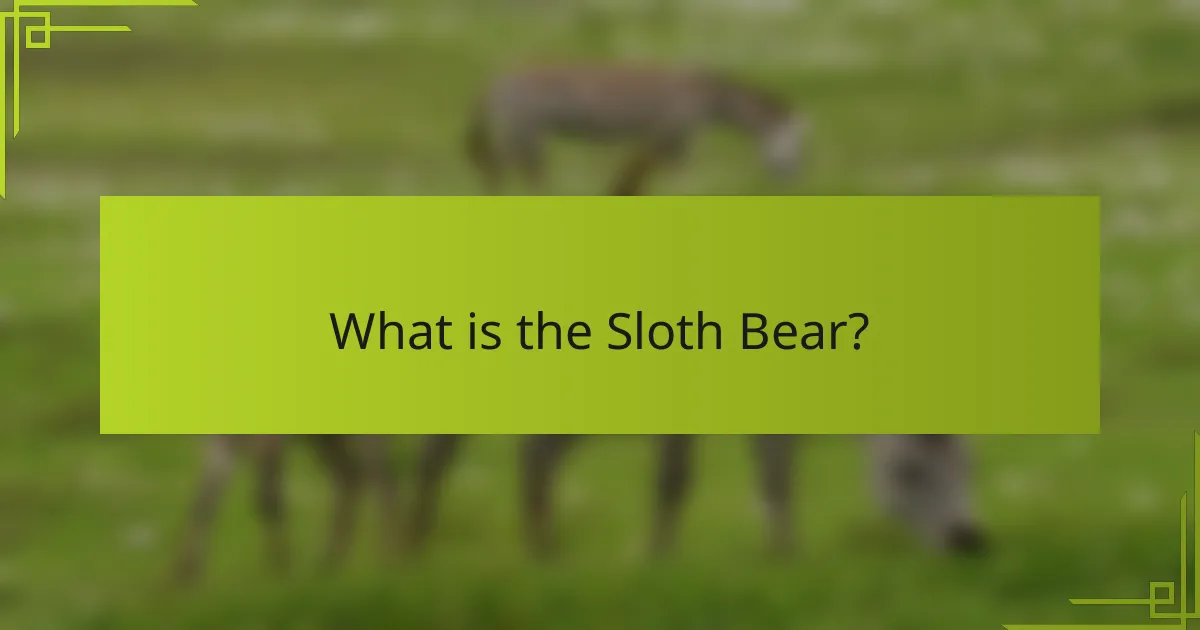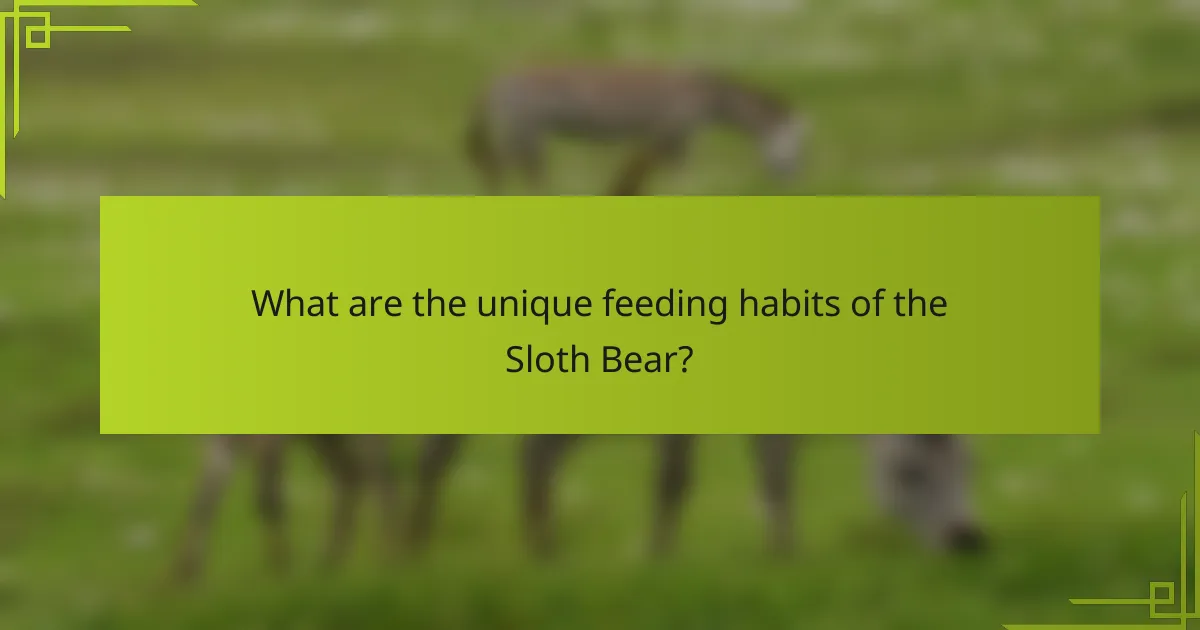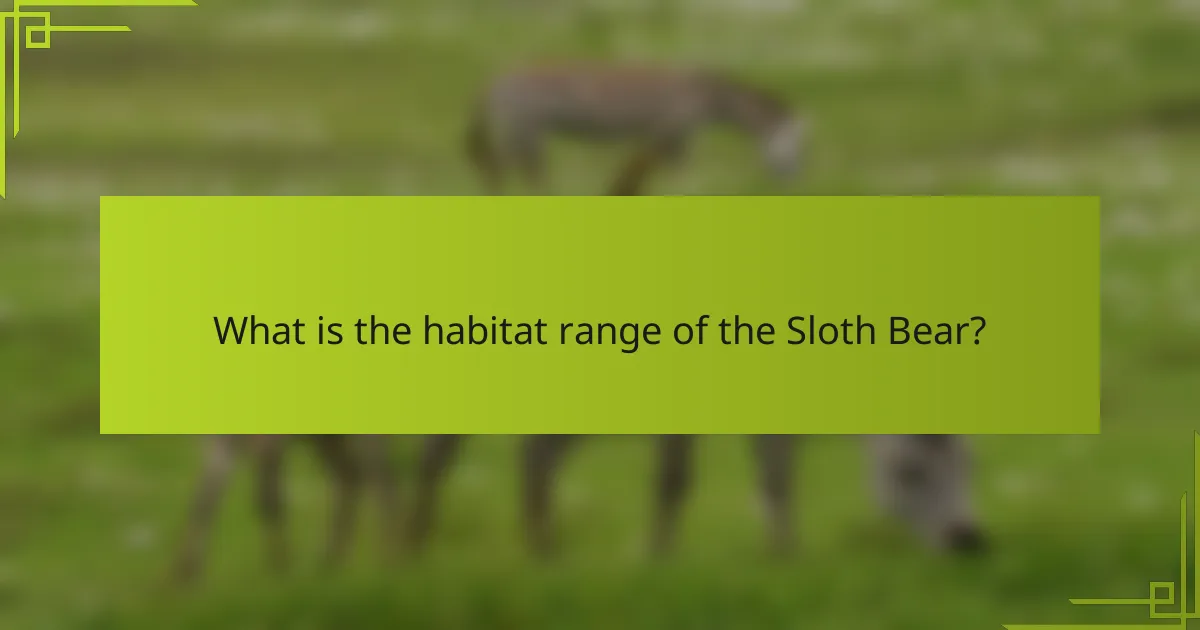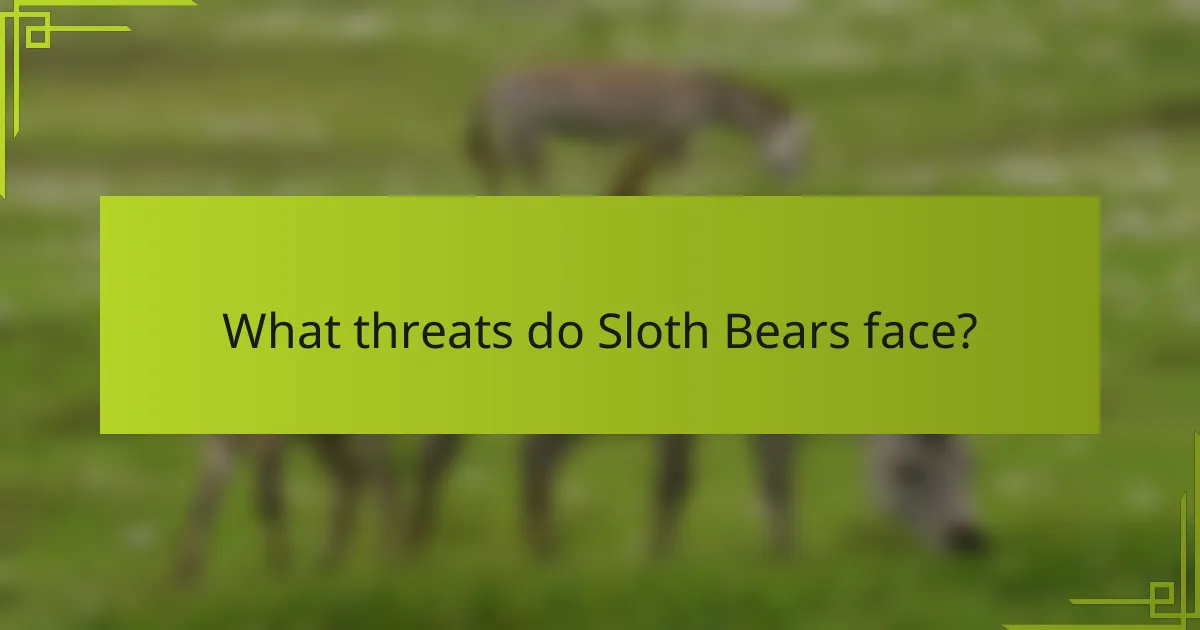The Sloth Bear (Melursus ursinus) is a native species of bear found in the Indian subcontinent, recognized for its shaggy black fur and distinctive white chest mark. This bear primarily feeds on insects, particularly termites and ants, using its long snout to extract them from mounds, and it also consumes fruits and honey. Sloth Bears inhabit tropical and subtropical forests, grasslands, and areas near human settlements across India, Nepal, Bhutan, Sri Lanka, and parts of Bangladesh. However, they face significant threats such as habitat loss due to deforestation, human-wildlife conflict, poaching, and the impacts of climate change, leading to their classification as a vulnerable species on the IUCN Red List.

What is the Sloth Bear?
The Sloth Bear is a species of bear native to the Indian subcontinent. It is scientifically known as Melursus ursinus. This bear is characterized by its shaggy black fur and a distinctive white chest mark. Sloth Bears primarily feed on insects, particularly termites and ants. Their long snouts are adapted for sucking insects out of their nests. They are generally nocturnal and prefer forested habitats. Sloth Bears are known for their unique behavior of breaking open termite mounds. They are listed as vulnerable due to habitat loss and poaching. Conservation efforts are essential for their survival in the wild.
How does the Sloth Bear differ from other bear species?
The Sloth Bear differs from other bear species primarily in its diet and physical characteristics. It primarily feeds on insects, particularly termites and ants, unlike many bears that are omnivorous. Sloth Bears have a long snout and a gap between their teeth, adapted for sucking insects. Their shaggy fur is also distinctive, providing protection against the elements in their natural habitat. Additionally, Sloth Bears are known for their unique behavior of standing on their hind legs to reach higher food sources. This species is primarily found in the Indian subcontinent, setting it apart geographically from other bear species. Their nocturnal habits further differentiate them, as many bears are diurnal. These adaptations make the Sloth Bear uniquely suited to its environment and feeding habits.
What are the physical characteristics of the Sloth Bear?
Sloth bears have distinct physical characteristics. They possess a shaggy black coat with a pronounced mane. Their bodies are stocky and robust, adapted for their unique feeding habits. Sloth bears have long, curved claws, ideal for digging into termite mounds. Their snouts are elongated, allowing for an efficient feeding mechanism. [censured] sloth bears typically weigh between 120 to 300 pounds. They stand about 5 to 6 feet tall when on their hind legs. Additionally, sloth bears have a distinctive white or cream-colored V-shaped mark on their chest. These traits help them thrive in their natural habitats.
What unique behaviors are exhibited by the Sloth Bear?
Sloth bears exhibit unique behaviors such as nocturnal foraging and tree climbing. They primarily forage at night, which helps them avoid daytime heat. Sloth bears are known for their distinctive feeding method, using their long claws to dig for insects and honey. They can climb trees to access beehives and fruits. These bears also communicate through vocalizations and scent marking. Their social interactions include playful behavior, especially among cubs. Sloth bears show a strong maternal instinct, with mothers caring for cubs for up to two years. These behaviors are crucial for their survival in their natural habitats.
What is the historical background of the Sloth Bear?
The Sloth Bear (Melursus ursinus) has a historical background rooted in its evolution and distribution. This species is believed to have diverged from other bear species around 3 to 4 million years ago. Sloth Bears are primarily found in the Indian subcontinent, including India, Nepal, and Sri Lanka. Historical records indicate that they were once more widespread, occupying various forested regions.
Their diet and behavior have evolved to adapt to their environment. Sloth Bears are known for their unique feeding habits, primarily consuming insects like termites and ants. This specialization has influenced their habitat preferences. Cultural references to Sloth Bears appear in ancient Indian texts, indicating their long-standing presence in human history.
In the 19th century, naturalists began documenting Sloth Bears more extensively, contributing to their recognition as a distinct species. Today, they face threats from habitat loss and poaching, impacting their population numbers.
Where did the Sloth Bear originate?
The Sloth Bear originated in the Indian subcontinent. This species is primarily found in India, Nepal, Bhutan, and Sri Lanka. Fossil evidence suggests that Sloth Bears have existed in this region for several million years. Their habitat includes tropical forests, grasslands, and scrublands. The bear’s unique adaptations have evolved to suit these environments. Historically, they have been a part of local folklore and culture in these areas.
How has the Sloth Bear’s population changed over time?
The Sloth Bear’s population has decreased significantly over time. Historical estimates suggested a larger population across India and surrounding regions. However, habitat loss and poaching have led to a decline in numbers. Current estimates indicate that the population may be fewer than 20,000 individuals. Conservation efforts are ongoing to protect their habitats and reduce human-wildlife conflict. Studies show that protected areas have helped stabilize some local populations. Nevertheless, the overall trend remains concerning due to ongoing threats.

What are the unique feeding habits of the Sloth Bear?
Sloth bears have unique feeding habits characterized by their insectivorous diet. They primarily consume termites and ants, using their long snouts to extract these insects from mounds. Sloth bears also forage for fruits, especially in the summer months. They are known to eat honey, which they access by breaking into beehives. Their strong claws assist in digging and tearing apart decayed wood to find insects. This diverse diet helps them adapt to varying habitats. Studies show that sloth bears can consume up to 20,000 insects in a single day. Their feeding behavior is essential for maintaining ecological balance by controlling insect populations.
What does the Sloth Bear primarily eat?
The Sloth Bear primarily eats insects, particularly termites and ants. This bear uses its long snout to suck insects from their nests. Additionally, it consumes fruit, honey, and flowers. The diet varies based on seasonal availability. Sloth Bears are known to forage for food in trees and on the ground. They have a unique feeding method that allows them to access hidden food sources. Their preference for insects is a key aspect of their ecological role. This diet helps maintain insect populations in their habitats.
How does the Sloth Bear’s diet differ by season?
The Sloth Bear’s diet varies significantly by season. During the dry season, Sloth Bears primarily consume ants and termites, which are abundant and accessible. They use their long snouts and claws to dig into mounds for these insects. In contrast, the wet season sees a shift to fruits and berries, as these become more plentiful. Sloth Bears actively forage for ripe fruits, which provide essential nutrients. This seasonal dietary change supports their energy needs throughout the year. Research indicates that this adaptability helps them thrive in diverse habitats across India and Sri Lanka.
What role do insects play in the Sloth Bear’s diet?
Insects are a significant component of the Sloth Bear’s diet. Sloth Bears primarily consume termites and ants, which provide essential protein. These bears use their long snouts to access insect nests. Their strong claws help to dig into the ground or wood to find these insects. Insects make up a substantial portion of their caloric intake, especially during the dry season. Research indicates that a Sloth Bear can consume up to 20,000 insects in a single day. This high intake is crucial for their energy needs, particularly when other food sources are scarce. Overall, insects play a vital role in the nutritional balance of the Sloth Bear’s diet.
How does the Sloth Bear forage for food?
The Sloth Bear forages for food primarily by using its long snout to extract insects and fruits. This bear species is known for its unique feeding habits, which include tearing open termite mounds and ant hills. Sloth Bears primarily consume termites, ants, and honey, but they also eat fruits like mangoes and berries. They have a specialized diet that allows them to thrive in their natural habitats. Their foraging behavior often involves digging and rooting around in the ground. Sloth Bears are nocturnal foragers, actively searching for food during the night. Their keen sense of smell helps them locate food sources efficiently. This unique foraging strategy is crucial for their survival in the wild.
What techniques do Sloth Bears use to extract food?
Sloth bears use their long snouts and powerful claws to extract food. They primarily feed on insects, particularly termites and ants. The bears dig into mounds with their claws to access these insects. Their snouts help them suck up the insects efficiently. Sloth bears also consume fruits and honey when available. They are known to climb trees to reach honeycombs. Their feeding techniques are adapted to their environment and food sources. This behavior showcases their unique adaptations for foraging.
How does the Sloth Bear’s sense of smell aid in feeding?
The Sloth Bear’s sense of smell is highly developed and crucial for feeding. This bear can detect food sources from significant distances, often up to several kilometers. Its olfactory receptors are more sensitive than those of many other mammals. This allows Sloth Bears to locate fruit, insects, and carrion effectively. They primarily feed on termites and ants, which are often hidden underground. The ability to smell these food sources helps them dig efficiently. Research indicates that their foraging success is directly linked to their acute sense of smell. This adaptation is essential for their survival in diverse habitats.

What is the habitat range of the Sloth Bear?
The habitat range of the Sloth Bear primarily includes the forests and grasslands of the Indian subcontinent. This species is found in India, Nepal, Bhutan, Sri Lanka, and parts of Bangladesh. Sloth Bears prefer tropical and subtropical moist broadleaf forests, dry forests, and scrublands. They are adaptable and can also inhabit areas near human settlements. Their range extends from the foothills of the Himalayas to the southern tip of India. Sloth Bears require habitats with abundant food sources, such as termites and fruits. Their presence is often associated with regions that provide cover and nesting sites.
Where can Sloth Bears be found in the wild?
Sloth Bears can be found in the wild across the Indian subcontinent. Their primary habitat includes forests, grasslands, and scrublands. They are predominantly located in India, Sri Lanka, Nepal, and Bhutan. Sloth Bears prefer areas with abundant food sources, such as termites and fruits. These bears are known to inhabit both tropical and subtropical regions. Their range extends from the western Ghats to the Himalayan foothills. In India, they are commonly found in national parks and wildlife sanctuaries. Their presence in diverse ecosystems highlights their adaptability to different environments.
What types of environments do Sloth Bears prefer?
Sloth Bears prefer forested and scrub habitats. They are commonly found in tropical and subtropical regions. These environments provide ample food sources, such as termites and fruits. Sloth Bears are also known to inhabit grasslands and areas near water sources. They thrive in environments with dense vegetation for shelter. Their preference for these habitats supports their foraging behavior. In India, they are often found in protected reserves that offer these conditions. This preference helps them avoid human interaction and threats.
How do geographical factors influence Sloth Bear habitats?
Geographical factors significantly influence Sloth Bear habitats. These bears primarily inhabit dry deciduous forests, grasslands, and scrublands in India and surrounding regions. The availability of food sources, such as termites and fruits, is directly affected by the type of vegetation present in these areas. Elevation and climate also play crucial roles in determining habitat suitability. For instance, Sloth Bears thrive in regions with a warm climate and adequate rainfall. Additionally, geographical barriers like mountains and rivers can limit their movement and access to resources. Studies indicate that habitat fragmentation due to human activities further impacts their distribution and survival.
How does habitat loss affect Sloth Bear populations?
Habitat loss significantly reduces Sloth Bear populations. This occurs as their natural habitats, such as forests and grasslands, are destroyed or fragmented. Consequently, Sloth Bears face decreased availability of food sources, like fruits and insects. Research indicates that habitat fragmentation leads to isolation of bear populations. Isolated populations suffer from reduced genetic diversity. This can result in inbreeding and lower resilience to disease. Studies show that habitat loss can lead to increased human-bear conflicts. Such conflicts often result in the bears being killed or relocated. Overall, habitat loss poses a critical threat to the survival of Sloth Bear populations.
What are the main causes of habitat destruction for Sloth Bears?
The main causes of habitat destruction for Sloth Bears are deforestation, agriculture, and urbanization. Deforestation occurs due to logging and land clearing for timber. Agriculture expands into bear habitats, reducing available food sources. Urbanization leads to increased infrastructure development, fragmenting their living areas. These activities result in habitat loss and degradation. According to the International Union for Conservation of Nature (IUCN), habitat destruction is a significant threat to Sloth Bear populations.
How does urbanization impact Sloth Bear habitats?
Urbanization significantly impacts Sloth Bear habitats by reducing their natural living space. As cities expand, forests and grasslands are cleared for development. This leads to habitat fragmentation, isolating bear populations. Sloth Bears rely on these habitats for food and shelter. Urban areas also increase human-wildlife conflict, as bears may venture into populated regions searching for food. Roads and infrastructure further restrict their movement. Research indicates that habitat loss threatens their survival, with some populations declining by over 30% in urbanized areas.

What threats do Sloth Bears face?
Sloth bears face several significant threats. Habitat loss is a primary concern, driven by deforestation and land conversion for agriculture. This reduces their natural living spaces and food sources. Human-wildlife conflict also poses a danger, as bears may raid crops, leading to retaliatory killings by farmers. Poaching for bear bile and other body parts further threatens their population. Additionally, climate change impacts their habitat and food availability. According to the IUCN Red List, sloth bears are classified as vulnerable, indicating a declining population trend due to these threats.
What are the primary threats to Sloth Bear survival?
The primary threats to Sloth Bear survival include habitat loss, poaching, and human-wildlife conflict. Habitat loss occurs due to deforestation and agricultural expansion, which reduces their living space. Poaching targets Sloth Bears for their body parts, which are used in traditional medicine. Human-wildlife conflict arises when bears raid crops or come into contact with humans, leading to retaliatory killings. According to the IUCN, habitat destruction and poaching significantly contribute to their declining population. Conservation efforts are critical to mitigate these threats and protect Sloth Bears.
How does poaching affect Sloth Bear populations?
Poaching significantly impacts Sloth Bear populations by reducing their numbers and disrupting their social structure. Illegal hunting targets Sloth Bears for their body parts, such as claws and bile, used in traditional medicine. This practice leads to population decline, making it difficult for bears to reproduce and maintain genetic diversity.
According to a study published in the journal “Biodiversity and Conservation,” poaching has contributed to a 30% decline in Sloth Bear populations over the past two decades. Additionally, habitat loss due to poaching activities further exacerbates their vulnerability. As a result, Sloth Bears face increased threats to their survival and overall ecosystem balance.
What role does climate change play in threatening Sloth Bears?
Climate change significantly threatens Sloth Bears by altering their habitat and food sources. Rising temperatures and changing precipitation patterns impact the availability of fruits and insects, which are crucial for their diet. Deforestation linked to climate change further reduces their natural habitat. As their environment changes, Sloth Bears may struggle to find adequate food and shelter. Additionally, increased human-wildlife conflict arises as bears search for resources in altered landscapes. Studies indicate that habitat loss and food scarcity due to climate change could lead to population declines.
What conservation efforts are in place for Sloth Bears?
Conservation efforts for Sloth Bears include habitat protection and legal protection. Various national parks and wildlife sanctuaries in India are designated to safeguard their natural habitats. The Wildlife Protection Act of 1972 in India provides legal protection to Sloth Bears. Organizations like the Wildlife Trust of India are actively involved in Sloth Bear conservation projects. They focus on research, awareness programs, and community engagement to mitigate human-bear conflicts. Additionally, initiatives aim to restore degraded habitats and monitor bear populations. These efforts are crucial for ensuring the survival of Sloth Bears in the wild.
How can local communities contribute to Sloth Bear conservation?
Local communities can contribute to Sloth Bear conservation by engaging in habitat protection and awareness initiatives. These communities can establish protected areas to safeguard Sloth Bear habitats. They can also participate in educational programs to raise awareness about the importance of Sloth Bears in the ecosystem. In India, local communities have successfully implemented community-based conservation projects. Such projects often involve training locals as wildlife monitors, which helps reduce human-wildlife conflict. Additionally, sustainable tourism initiatives can provide economic benefits while promoting conservation efforts. Studies show that community involvement significantly enhances conservation outcomes. For instance, a report by the Wildlife Institute of India indicates that local stewardship leads to better protection of biodiversity.
What organizations are dedicated to protecting Sloth Bears?
Organizations dedicated to protecting Sloth Bears include the Wildlife Trust of India and the World Wildlife Fund. The Wildlife Trust of India focuses on habitat conservation and community engagement. They work to mitigate human-animal conflict in regions where Sloth Bears reside. The World Wildlife Fund supports various conservation initiatives aimed at protecting Sloth Bears and their habitats. These organizations conduct research and raise awareness about the threats facing Sloth Bears. Their efforts contribute to the preservation of this vulnerable species.
What can individuals do to help protect Sloth Bears?
Individuals can help protect Sloth Bears by supporting wildlife conservation efforts. Donations to organizations focused on Sloth Bear protection fund habitat preservation initiatives. Participating in local clean-up activities reduces pollution in their habitats. Educating others about Sloth Bears raises awareness of their plight. Advocating for stricter wildlife protection laws can lead to better regulations. Reporting illegal activities, such as poaching, helps enforce laws protecting these animals. Responsible tourism practices minimize human-bear conflicts. By reducing plastic use, individuals can decrease habitat degradation caused by waste.
The Sloth Bear (Melursus ursinus) is a unique species native to the Indian subcontinent, characterized by its shaggy black fur, long snout, and distinctive white chest mark. This article explores the Sloth Bear’s unique feeding habits, primarily focusing on its insectivorous diet, habitat preferences, and the threats it faces, including habitat loss, poaching, and climate change. Key aspects of its behavior, physical characteristics, and conservation efforts are also discussed, highlighting the importance of protecting this vulnerable species and its natural environment.
